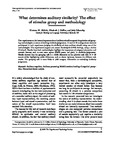What determines auditory similarity? The effect of stimulus group and methodology
| dc.contributor.author | Aldrich, KM | |
| dc.contributor.author | Hellier, Elizabeth | |
| dc.contributor.author | Edworthy, Judy | |
| dc.date.accessioned | 2014-03-17T11:48:56Z | |
| dc.date.available | 2014-03-17T11:48:56Z | |
| dc.date.issued | 2009-01 | |
| dc.identifier.issn | 1747-0218 | |
| dc.identifier.issn | 1747-0226 | |
| dc.identifier.uri | http://hdl.handle.net/10026.1/2918 | |
| dc.description.abstract |
<jats:p> Two experiments on the internal representation of auditory stimuli compared the pairwise and grouping methodologies as means of deriving similarity judgements. A total of 45 undergraduate students participated in each experiment, judging the similarity of short auditory stimuli, using one of the methodologies. The experiments support and extend Bonebright's (1996) findings, using a further 60 stimuli. Results from both methodologies highlight the importance of category information and acoustic features, such as root mean square (RMS) power and pitch, in similarity judgements. Results showed that the grouping task is a viable alternative to the pairwise task with N > 20 sounds whilst highlighting subtle differences, such as cluster tightness, between the different task results. The grouping task is more likely to yield category information as underlying similarity judgements. </jats:p> | |
| dc.format.extent | 63-83 | |
| dc.format.medium | Print-Electronic | |
| dc.language | en | |
| dc.language.iso | eng | |
| dc.publisher | SAGE Publications | |
| dc.subject | Auditory cognition | |
| dc.subject | Auditory processing | |
| dc.subject | Multidimensional scaling | |
| dc.subject | Categorical perception | |
| dc.subject | Hierarchical cluster analysis | |
| dc.title | What determines auditory similarity? The effect of stimulus group and methodology | |
| dc.type | journal-article | |
| dc.type | Journal Article | |
| plymouth.author-url | https://www.webofscience.com/api/gateway?GWVersion=2&SrcApp=PARTNER_APP&SrcAuth=LinksAMR&KeyUT=WOS:000265836800008&DestLinkType=FullRecord&DestApp=ALL_WOS&UsrCustomerID=11bb513d99f797142bcfeffcc58ea008 | |
| plymouth.issue | 1 | |
| plymouth.volume | 62 | |
| plymouth.publication-status | Published | |
| plymouth.journal | Quarterly Journal of Experimental Psychology | |
| dc.identifier.doi | 10.1080/17470210701814451 | |
| plymouth.organisational-group | /Plymouth | |
| plymouth.organisational-group | /Plymouth/Faculty of Health | |
| plymouth.organisational-group | /Plymouth/REF 2021 Researchers by UoA | |
| plymouth.organisational-group | /Plymouth/REF 2021 Researchers by UoA/UoA04 Psychology, Psychiatry and Neuroscience | |
| plymouth.organisational-group | /Plymouth/Research Groups | |
| plymouth.organisational-group | /Plymouth/Research Groups/Centre for Brain, Cognition and Behaviour (CBCB) | |
| plymouth.organisational-group | /Plymouth/Research Groups/Centre for Brain, Cognition and Behaviour (CBCB)/Behaviour | |
| plymouth.organisational-group | /Plymouth/Users by role | |
| dc.publisher.place | England | |
| dc.identifier.eissn | 1747-0226 | |
| dc.rights.embargoperiod | Not known | |
| rioxxterms.versionofrecord | 10.1080/17470210701814451 | |
| rioxxterms.licenseref.uri | http://www.rioxx.net/licenses/all-rights-reserved | |
| rioxxterms.type | Journal Article/Review |


